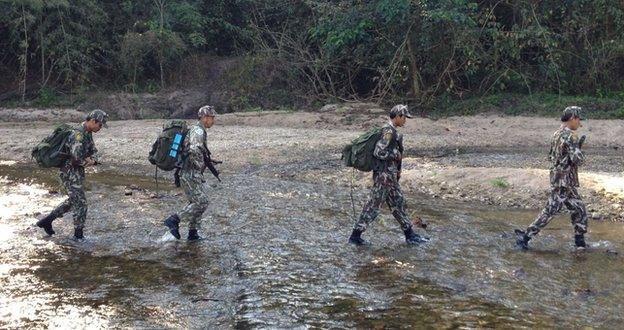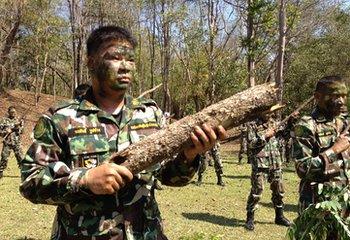Deadly poison threat to tigers
- Published
David Shukman joins the team at a Thai tiger sanctuary
Poison is emerging as the latest and most dangerous threat to the survival of the last remaining wild tigers in Thailand.
Poachers targeting tigers for their valuable skins and body parts are turning to insecticide as an easy way to kill the iconic animals.
In what's regarded as Thailand's most important tiger sanctuary, wildlife rangers report mounting evidence of gangs setting traps with fresh meat, laced with poison, as bait.
In one particularly shocking incident, two tiger cubs were found close to death after eating the bait. By the time they had been discovered, it was too late to save them.
Rangers described the frustration of finding the cubs and seeing them in extreme pain but too far gone to be revived.
The two tiny animals had crawled into the bush to die so the poachers had failed to notice them. But they had evidently located the cubs' mother and made off with her body because no trace was seen of her.
The poachers had shot and butchered an elephant to create a supply of fresh meat for their trap. Before the tigers found it, some of the bait had been eaten by wild dogs, civet cats and even a monitor lizard - and all had died.
For the rangers, it was a painful loss. As the superintendent of the sanctuary, Sompoch Maneerat, put it: "any time we see even one tiger killed, I feel a pain in my heart".
Fragile stronghold
Tigers are vulnerable because their numbers are already desperately low. In the Huai Kha Khang sanctuary, only 38 have been definitively identified, with statistical models suggesting that the actual total might be 53-65.
In the country as a whole, the best estimate is that no more than 200 tigers remain in the wild - a massive decline in the space of a few decades.
Huai Kha Khang is seen as the most viable tiger stronghold but even here their survival is highly fragile.
With prices soaring for the tigers' skins, genitals, bones and teeth, poaching gangs have become increasingly aggressive and well-organised, even mounting intelligence-gathering operations against the rangers to understand their patrol patterns.

Wildlife rangers can get into gun battles with the poachers
While the poachers are always armed with modern weapons - and have been known to use them on tigers - the technique of lacing bait is far less arduous and carries fewer risks.
Dr Anak Pattanavibool, director of the Wildlife Conservation Society in Thailand, says that if the intensity of patrolling slackens even briefly, large numbers of tigers could be poisoned very rapidly.
"If we relax our patrols even a little bit, we would lose many tigers to poachers," he said.
"If we relax just for three months that means we cannot stop poacher gangs coming in for those three months and in that time only one poacher gang could poison twenty tigers - a third of the population here."
Dr Pattanavibool, himself a former ranger, has been working with the sanctuary authorities to introduce a system of "smart patrolling" to keep ahead of the poachers.
No remorse
Every trace of the presence of tigers - from camera-trap photographs to paw prints - is recorded and mapped along with any evidence of poachers such as spent cartridges or camp fires.
The aim is to build up an accurate and up to date picture of where both the tigers and the poachers are likely to be so that the patrols can be targeted in the most effective locations.
The system has been running since 2005 and can be judged a success in that tiger numbers, though still worryingly low, have been inching slightly higher.

There aren't enough guns to go round, so some recruits train with substitutes
Two poachers who were caught and convicted had even photographed themselves, AK-47s in hand, straddling a tiger that they had just killed. But the fact that they are now in jail has not deterred others.
The sanctuary has about 200 rangers to guard its almost 3,000 sq km - a far lower number compared to an equivalent tiger reserve in India.
The superintendent, Mr Maneerat, describes the campaign to save the tigers in military terms.
He says he is short of men and weapons. The rangers each get a gun on patrol but the unit overall does not have enough guns for each man to be issued one personally. At one training session, I watched many of the rangers practising rifle drill with sticks.
"I have to say the poachers, especially the professionals who are acting to orders, have more modern weapons with better quality than we do," he said.
"So we have to train our staff to be more efficient, to mount better patrols, we have to do our best."

Each loss of a tiger is seen as a failure and has often led to recriminations and even sackings, even though the rangers face an almost impossible task.
One ranger, Somtawin Kanya, who has worked here for 16 years, described being in several gun battles with poachers.
He was also at the scene when the two tiger cubs were found poisoned.
"They had lived for less than a day after eating it," he said, "and they died within 200m of the poisoned bait."
Poison had first been used in the sanctuary back in the 1980s and led to the extinction of red-headed vultures - the last 25 birds were killed by it.
Then it re-emerged as a threat in 2010 when poisoned bait was found in about 10 separate locations along the boundary between the sanctuary and a neighbouring reserve.
I asked Dr Pattanavibool for his view of the future.
"It's hard to say we are winning. We might be winning at the moment but we have to keep on doing this and trying to do better because the poachers never stop - they will try to find a way in all the time."
- Published4 February 2013
- Published15 February 2012
- Published24 November 2010